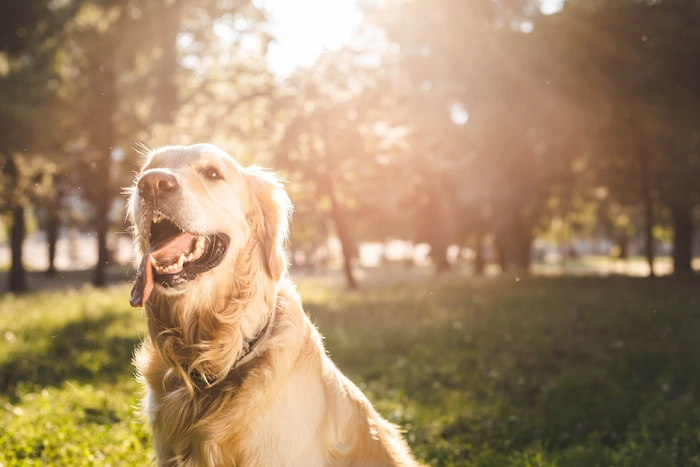Your dog has an internal body temperature between 101 and 102.5 degrees. In hot weather, your dog’s body temperature can rise high enough to result in hyperthermia. You probably know this condition better as heat stroke, and it can happen to dogs even faster than to pet parents.
Keeping your dog cool should be a top priority on a hot summer day. Below, we discuss ten crucial dog safety tips to help you keep your dog comfortable and how to cool a dog down so the summer fun can continue without any unfortunate incidents.
1. Provide Ample Shade
When you’re outside during warmer weather, ensure your pup has access to ample shade to avoid direct sunlight. Shade can come from a dog house, porch or trees.
2. Fresh Cool Water at All Times
Whether you’re enjoying a hot summer’s day with your dog outside or inside, provide plenty of cool water. Warmer weather makes dehydration more likely, so check the water bowl multiple times throughout the day and refill it whenever needed.
If you’re outside, leave the garden hose running on low in the water bowl so your dog always has access to a cool drink. Avoid placing the bowl in the hot sun if possible.
You may have heard that cold water is dangerous for your dog, and you should only offer room-temperature water. However, new evidence shows that chilled water is perfectly safe on its own — but you may want to avoid it if your dog is too hot. It’s not the ice cubes that are inherently dangerous but cooling your dog off too quickly.
3. Avoid Hot Surfaces
Your dog’s paws are susceptible to heat. Walking on surfaces such as asphalt, pavement and sand in hot weather can cause your dog’s paw pads to burn. Opt to walk your dog on grass or shaded areas on hot days. You can also use special protective booties for your dog’s feet if hot surfaces can’t be avoided.
4. Never Leave Your Dog in a Parked Car
Did you know that when it’s 95 degrees outside, the inside of a parked car will reach an average temperature of 116 degrees within 1 hour? Even cars parked in the shade reach an average of 100 degrees within that first hour. These temperatures place your dog at a high risk of heat stroke if left inside for even a brief period.
If you must run inside a store while you have your dog, avoid leaving it in the hot car. Instead, bring your dog inside if the store allows it. Or leave a passenger inside the vehicle with the dog and ensure the air conditioning is running.
If neither of these options is possible, try a drive-thru or take your dog home before you run errands. Your dog’s life depends on it.
5. Schedule Walks During Cooler Times
Every dog breed has different exercise requirements. With some of the more relaxed breeds, you can likely get away with one to two walks daily if your dog has access to a safe yard as necessary throughout the day.
For these dogs, schedule your walks in the early morning and late evening. With a smaller or older dog, you can opt for two 10-minute walks daily.
More energetic dogs may require more frequent exercise, or they could become destructive or even depressed. Keeping an energetic pup cool while still getting enough exercise requires a balance that feels challenging to achieve.
For these dogs, consider three shorter walks of 10 or 15 minutes. Good times to do this are in the morning before work, right after dinner and later in the evening, just before dark.
If your pup needs more exercise between these walks (or you can’t manage three walks daily), consider placing a dog pool in a shaded area of your yard. Let your dog stay cool and have fun in the water as long as it remains comfortable. You can throw frozen dog toys in the pool for extra fun on a hot day, but avoid using so many that you create cold water.
6. Know the Signs of an Overheated Dog
When your dog’s body temperature gets too high, it can lead to heat stroke. A heat stroke is a medical emergency that can be fatal if not treated immediately. For this reason, be sure you know the signs of an overheated dog and take it to the vet immediately if you notice any.
Signs your dog is overheated include:
- Excessive panting
- Barking, whining or other signs of agitation
- Excessive thirst and signs of dehydration
- Excessive drooling
- Lethargy
- Vomiting
- Unsteadiness
7. Learn How to Cool a Dog Down
There are several cooling aid options you can use to help keep dogs cool on a hot day. These include cooling mats, bandanas and cooling vests.
Offering frozen treats or frozen dog toys can also be helpful for cooling a hot dog. You can make homemade frozen dog treats using peanut butter, plain yogurt and dog-safe fruits.
Research these options to determine the best for your pet. Once you purchase one, read the instructions carefully so you know how to cool your dog down properly. Keep these on hand and utilize them whenever your dog has to go outside when the weather is uncomfortably hot.
If you don’t have any of these special products on hand, you can use a wet or damp towel on your pup’s underbelly.
8. Trim Fur (But Avoid Shaving)
It may seem like shaving off all its fur would keep your pet cool, but that’s not exactly true. Long or short, coats play a role in regulating your dog’s temperature by providing insulation and protection from the sun.
However, keeping your dog’s fur trimmed and tidy is important to reduce extra weight or heat. Good grooming is different for every dog, so we suggest consulting with a professional dog groomer. They can help you determine the best practices for keeping your dog’s coat neat, trimmed and effective.
9. Keep It Inside in Hot Weather
The best way to cool down a dog is by never letting it get overheated in the first place, and keeping it inside in the cool air is the best prevention method. Keep the AC on to create a comfortable air temperature, and use a fan to create a cool breeze where your dog lays most often.
Comfortable indoor temperatures can sometimes be hard to maintain when the outside temperature gets high. When this happens, consider adding a cooling mat to your dog’s favorite lounging spot to create a cold surface it can access whenever it wants.
10. Monitor Brachycephalic Breeds Closely
Brachycephalic breeds, such as bulldogs, pugs and boxers, have short snouts. These breeds are more prone to overheating because they can’t pant as effectively. If you have a brachycephalic breed, monitor it closely and try to keep your dog indoors.
Keep Your Dog Cool This Summer

Following the above heat safety tips ensures your dog stays cool and safe during the summer months. The Halo Collar offers a holistic approach to boundary training, making it essential to prevent your dog from straying too far in the heat. Its waterproof feature allows your dog to take a refreshing swim to cool down without the worry of damaging the collar. This advanced system creates a virtual fence for your pup and strengthens the bond between you and your dog, promoting a healthier lifestyle.
Remember, close supervision and hydration are key to reducing the risk of overheating, and with the Halo Collar, you can enjoy the summer with your furry friend with peace of mind.










